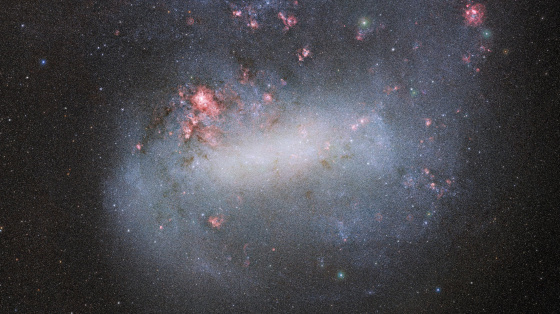The baritones among Red giants refine cosmic distance measurements
In a constantly expanding universe, measuring cosmic distances is like trying to find a reliable ruler in a vast, ever-stretching fabric. One tool that astrophysicists use is the Hubble constant (H0) which measures how fast the Universe is expanding and sets the age and observable size of the Universe. However, there is disagreement over the value of H0, due to conflicting measurements derived from various celestial objects. The debate means that our understanding of the basic physics of the Universe is incomplete. The stakes are high, and the key to finding a resolution is to significantly improve the accuracy of distance measurements based on stars.
 The Large Magellanic cloud. Credit: CTIO/NOIRLab/NSF/AURA/SMASH/D. Nidever (Montana State University)
The Large Magellanic cloud. Credit: CTIO/NOIRLab/NSF/AURA/SMASH/D. Nidever (Montana State University)
Image processing: Travis Rector (University of Alaska Anchorage), Mahdi Zamani & Davide de Martin.
In a new study stemmed from a collaboration between EPFL and UNIGE researchers, the cosmic distance measurements are refined using the sonorous signals from Red giants: “We found that the acoustic oscillations of red giant stars tell us how to best measure cosmic distances using the Tip of the Red Giant Branch method,” says Richard Anderson (EPFL), first author of the letter published in the Astrophysical Journal.
Measuring cosmic distances with Red Giants
“Red Giants are aging stars." explains Laurent Eyer (UNIGE), co-author of the letter, and coordinator of the Variability processing and analysis Unit of the Gaia mission (CU7). "They adopt a reddish hue as they exhaust hydrogen in their cores and use outer hydrogen, which makes them larger and cooler." On astronomical diagrams, this evolution leads to a band that the stars climb due to their increased brightness: the “Red Giant Branch”. The Tip of the Red Giant Branch (TRGB) is a critical point where these stars ignite helium, reversing brightness evolution.
The TRGB, marked by fewer brighter stars above it in the diagram, serves as a "standard candle" for cosmic distance measurements: by comparing its known brightness to its observed brightness in distant galaxies, astronomers can calculate distance, much like estimating a light bulb's distance by its luminosity.
Singing in the dark
The researchers analysed data from the Optical Gravitational Lensing Experiment (OGLE) and the ESA Gaia mission to scrutinise Red Giants in the Large Magellanic Cloud (LMC), which is a nearby companion galaxy that orbits the Milky Way and serves as a crucial laboratory for understanding the physics of stars.
In a surprising twist, the scientists found that all stars at the TRGB actually vary in brightness periodically; sound waves travel through the stars like earthquakes on Earth, causing them to oscillate. While these oscillations were previously known, their importance for distance measurements was missed. But now, they allowed the researchers to distinguish stars by age, offering a more nuanced approach to measuring distances across the universe.
Richard Anderson explains: “Younger red giant stars near the TRGB are a little less bright than their older cousins, and the acoustic oscillations that we observe as brightness fluctuations allow us to understand which type of star we’re dealing with: the older stars oscillate at lower frequency – just like a baritone sings with a deeper voice than a tenor!” This distinction is crucial to ensure highly accurate distance measurements required for cosmology and for obtaining the best map of the local Universe, since Red Giant stars exist in virtually every galaxy.
The study also identifies several improvements to the TRGB distance method that are essential for understanding recent debates about the Hubble constant tension. “Now that we can distinguish the ages of the Red giants that make up the TRGB, we will be able to further improve the Hubble constant measurement based thereon,” says Richard Anderson. “Such improvements will further put the Hubble constant tension to the test and may lead to groundbreaking new insights into the basic physical processes that decide how the Universe evolves.”
Laurent Eyer concludes: "This study shows the incredible strength of the stellar variability analysis, and highlights strongly the crucial importance of what is called the Time-domain astronomy, where objects are observed as often as possible."
March 15, 2024News
